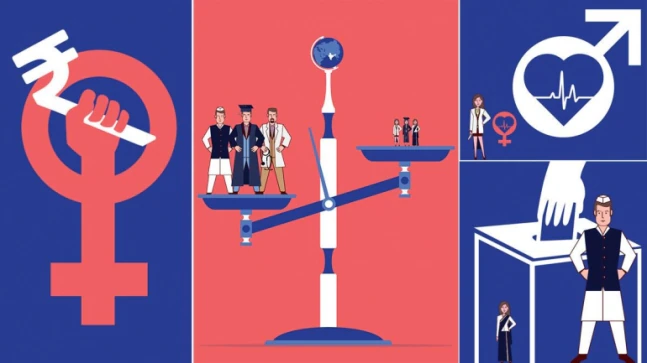
[ad_1]
India once again finds itself in an embarrassing and, more importantly, worrying position in the Gender Gap Index report published by the World Economic Forum (WEF). The 2022 report ranks India almost at the bottom, No. 135, among the 146 countries surveyed. This year’s overall score was 0.629; in past years, India’s gender gap score has oscillated between a low of 0.593 and high of 0.683, while top 10 countries score over 0.8.
The report calculates the gender gap between men and women in four key areas—economic opportunities, education, health and political empowerment. While India is at a decent rank of 48 in terms of political empowerment, it’s at the bottom of the list in health and survival. The WEF report reiterates the contradiction between improved social empowerment of women and their abysmal health indicators, as revealed by the fifth National Family Health Survey (NFHS) published earlier this year.
The NFHS showed that on several indicators—ownership of property and bank accounts, participation in household decision-making, percentage of underage marriage and use of internet/ mobile phone—Indian women have showed tangible improvement in the past six years (2015-22).
In contrast, the gap in health parameters is growing wider. The share of anaemic women has gone up to 57 per cent in the latest NFHS. The share of obese women is also up, at 24 per cent. Over one-fourth of Indian women are diabetic and nearly 40 per cent have high blood pressure. Though NFHS-5 revealed a healthy sex ratio of 1,020 women per 1,000 men, India’s record has not improved compared to other countries. Besides, the survey comes with a rider about comparing the trends as “some states and UTs may have smaller sample sizes”.
In education, the WEF survey, based on enrolment in primary, secondary and tertiary education, found girls were spending less years in school than boys. Union government data shows the mean years of schooling for girls was 4.7 years in 2018, whereas for boys it was almost double, 8.2 years.
The widest gap between men and women was seen in economic participation and opportunities, not just in India but across the Southeast Asian region. The rankings were based on the state of women in the country’s labour force participation, estimated earnings, share of professional and technical workers, wage equality and share of legislators, senior officials and managers.
Labour force participation by Indian women has registered a sharp decline. In 2010-20, labour force participation dropped from 26 per cent to 19 per cent, compared to the global average of nearly 50 per cent, says a World Bank report. There was an uptick in labour force participation by rural women in ’20-21, mapped by the official Periodic Labour Force Survey, but it’s seen as a mark of post-pandemic hunger for even low-paying jobs. ABloomberg report pegs female employment in India at a shocking 9 per cent in 2022.
The only area where India performs relatively better is political empowerment, evaluated on the basis of share in ministerial positions, in Parliament, and number of years with female/ male head of state. The WEF report says the share of women legislators, senior officials and managers rose to 17.6 per cent last year. The share of women MPs has jumped too, from 9 per cent to 14 per cent in the past 20 years.
The wide Indian gender gap
The Global Gender Gap Index was introduced by the World Economic Forum in 2006 to benchmark progress towards gender parity by countries. India figures among those ranked at the very bottom—pulling in at No. 135 out of 146 countries surveyed

India is worst in women’s health
The report compares gender gaps in countries across four dimensions—economic opportunities, education, health, and political leadership. India’s biggest cause of concern are health indicators where it has been consistently at the bottom

India among laggards in South Asia
Among all countries, South Asian nations rank the lowest with the widest gap in economic opportunities and health and second widest in educational attainment. India is placed a lowly 6th rank among our nine South Asian neighbours Indian Women: Empowered but in poor health

More women in political leadership
The share of women in Parliament and the assemblies has been gradually increasing since 2000. Their participation in the electoral process has also seen a spike. Not surprisingly, India has earned a respectable 48th position in the Global Gender Gap Index in this category


[ad_2]
Source link